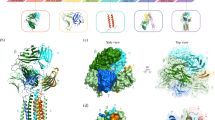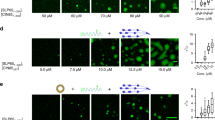Abstract
Phosphorylation of the T cell antigen receptor (TCR) by the tyrosine kinase Lck is an essential step in the activation of T cells. Because Lck is constitutively active, spatial organization may regulate TCR signaling. Here we found that Lck distributions on the molecular level were controlled by the conformational states of Lck, with the open, active conformation inducing clustering and the closed, inactive conformation preventing clustering. In contrast, association with lipid domains and protein networks were not sufficient or necessary for Lck clustering. Conformation-driven Lck clustering was highly dynamic, so that TCR triggering resulted in Lck clusters that contained phosphorylated TCRs but excluded the phosphatase CD45. Our data suggest that Lck conformational states represent an intrinsic mechanism for the intermolecular organization of early T cell signaling.
This is a preview of subscription content, access via your institution
Access options
Subscribe to this journal
Receive 12 print issues and online access
$209.00 per year
only $17.42 per issue
Buy this article
- Purchase on Springer Link
- Instant access to full article PDF
Prices may be subject to local taxes which are calculated during checkout






Similar content being viewed by others
References
Parsons, S.J. & Parsons, J.T. Src family kinases, key regulators of signal transduction. Oncogene 23, 7906–7909 (2004).
Huppa, J.B. & Davis, M.M. T-cell-antigen recognition and the immunological synapse. Nat. Rev. Immunol. 3, 973–983 (2003).
van der Merwe, P.A. & Dushek, O. Mechanisms for T cell receptor triggering. Nat. Rev. Immunol. 11, 47–55 (2011).
Palacios, E.H. & Weiss, A. Function of the Src-family kinases, Lck and Fyn, in T-cell development and activation. Oncogene 23, 7990–8000 (2004).
Yamaguchi, H. & Hendrickson, W.A. Structural basis for activation of human lymphocyte kinase Lck upon tyrosine phosphorylation. Nature 384, 484–489 (1996).
Boggon, T.J. & Eck, M.J. Structure and regulation of Src family kinases. Oncogene 23, 7918–7927 (2004).
Hermiston, M.L., Xu, Z. & Weiss, A. CD45: a critical regulator of signaling thresholds in immune cells. Annu. Rev. Immunol. 21, 107–137 (2003).
Saunders, A.E. & Johnson, P. Modulation of immune cell signalling by the leukocyte common tyrosine phosphatase, CD45. Cell. Signal. 22, 339–348 (2010).
D'Oro, U. & Ashwell, J.D. Cutting Edge: The CD45 tyrosine phosphatase is an inhibitor of Lck activity in thymocytes. J. Immunol. 162, 1879–1883 (1999).
Wong, N.K.Y., Lai, J.C.Y., Birkenhead, D., Shaw, A.S. & Johnson, P. CD45 down-regulates Lck-mediated CD44 signaling and modulates actin rearrangement in T cells. J. Immunol. 181, 7033–7043 (2008).
Davis, S.J. & van der Merwe, P.A. Lck and the nature of the T-cell receptor trigger. Trends Immunol. 32, 1–5 (2010).
Smith-Garvin, J.E., Koretzky, G.A. & Jordan, M.S. T cell activation. Annu. Rev. Immunol. 27, 591–619 (2009).
Paster, W. et al. Genetically encoded Förster resonance energy transfer sensors for the conformation of the Src family kinase Lck. J. Immunol. 182, 2160–2167 (2009).
Nika, K. et al. Constitutively active Lck kinase in T cells drives antigen receptor signal transduction. Immunity 32, 766–777 (2010).
Davis, S.J. & van der Merwe, P.A. The kinetic-segregation model: TCR triggering and beyond. Nat. Immunol. 7, 803–809 (2006).
Rossy, J., Williamson, D.J. & Gaus, K. How does the kinase Lck phosphorylate the T cell receptor? Spatial organization as a regulatory mechanism. Front. Immunol. 3, 167 (2012).
Douglass, A.D. & Vale, R.D. Single-molecule microscopy reveals plasma membrane microdomains created by protein-protein networks that exclude or trap signaling molecules in T cells. Cell 121, 937–950 (2005).
Rodgers, W., Farris, D. & Mishra, S. Merging complexes: properties of membrane raft assembly during lymphocyte signaling. Trends Immunol. 26, 97–103 (2005).
Lillemeier, B.F. et al. TCR and Lat are expressed on separate protein islands on T cell membranes and concatenate during activation. Nat. Immunol. 11, 90–96 (2010).
Williamson, D.J. et al. Pre-existing clusters of the adaptor Lat do not participate in early T cell signaling events. Nat. Immunol. 12, 655–662 (2011).
Sherman, E. et al. Functional nanoscale organization of signaling molecules downstream of the T cell antigen receptor. Immunity 35, 705–720 (2011).
Betzig, E. et al. Imaging intracellular fluorescent proteins at nanometer resolution. Science 313, 1642–1645 (2006).
Rust, M.J., Bates, M. & Zhuang, X. imaging by stochastic optical reconstruction microscopy (STORM). Nat. Methods 3, 793–795 (2006).
van de Linde, S. et al. Direct stochastic optical reconstruction microscopy with standard fluorescent probes. Nat. Protoc. 6, 991–1009 (2011).
Owen, D.M. et al. PALM imaging and cluster analysis of protein heterogeneity at the cell surface. J. Biophotonics 3, 446–454 (2010).
Bunnell, S.C. et al. Persistence of cooperatively stabilized signaling clusters drives T-cell activation. Mol. Cell Biol. 26, 7155–7166 (2006).
Campi, G., Varma, R. & Dustin, M.L. Actin and agonist MHC-peptide complex-dependent T cell receptor microclusters as scaffolds for signaling. J. Exp. Med. 202, 1031–1036 (2005).
Gaus, K., Chklovskaia, E., Fazekas de St Groth, B., Jessup, W. & Harder, T. Condensation of the plasma membrane at the site of T lymphocyte activation. J. Cell Biol. 171, 121–131 (2005).
Zech, T. et al. Accumulation of raft lipids in T-cell plasma membrane domains engaged in TCR signalling. EMBO J. 28, 466–476 (2009).
Rentero, C. et al. Functional implications of plasma membrane condensation for T cell activation. PLoS ONE 3, e2262 (2008).
Laham, L.E., Mukhopadhyay, N. & Roberts, T.M. The activation loop in Lck regulates oncogenic potential by inhibiting basal kinase activity and restricting substrate specificity. Oncogene 19, 3961–3970 (2000).
Rao, N. et al. Negative regulation of Lck by Cbl ubiquitin ligase. Proc. Natl. Acad. Sci. USA 99, 3794–3799 (2002).
Bunnell, S.C. et al. T cell receptor ligation induces the formation of dynamically regulated signaling assemblies. J. Cell Biol. 158, 1263–1275 (2002).
Grakoui, A. et al. The immunological synapse: a molecular machine controlling T cell activation. Science 285, 221–227 (1999).
Leupin, O., Zaru, R., Laroche, T., Müller, S. & Valitutti, S. Exclusion of CD45 from the T-cell receptor signaling area in antigen-stimulated T lymphocytes. Curr. Biol. 10, 277–280 (2000).
Johnson, K.G. A supramolecular basis for CD45 tyrosine phosphatase regulation in sustained T cell activation. Proc. Natl. Acad. Sci. USA 97, 10138–10143 (2000).
Varma, R., Campi, G., Yokosuka, T., Saito, T. & Dustin, M.L. T cell receptor-proximal signals are sustained in peripheral microclusters and terminated in the central supramolecular activation cluster. Immunity 25, 117–127 (2006).
Kaizuka, Y., Douglass, A.D., Vardhana, S., Dustin, M.L. & Vale, R.D. The coreceptor CD2 uses plasma membrane microdomains to transduce signals in T cells. J. Cell Biol. 185, 521–534 (2009).
Gan, W. & Roux, B. Binding specificity of SH2 domains: insight from free energy simulations. Proteins 74, 996–1007 (2009).
Hashimoto-Tane, A. et al. T-cell receptor microclusters critical for T-cell activation are formed independently of lipid raft clustering. Mol. Cell Biol. 30, 3421–3429 (2010).
Fairn, G.D. et al. High-resolution mapping reveals topologically distinct cellular pools of phosphatidylserine. J. Cell Biol. 194, 257–275 (2011).
Xu, W., Doshi, A., Lei, M., Eck, M.J. & Harrison, S.C. Crystal structures of c-Src reveal features of its autoinhibitory mechanism. Mol. Cell 3, 629–638 (1999).
Lee-Fruman, K.K., Collins, T.L. & Burakoff, S.J. Role of the Lck Src homology 2 and 3 domains in protein tyrosine phosphorylation. J. Biol. Chem. 271, 25003–25010 (1996).
Yeung, T. et al. Membrane phosphatidylserine regulates surface charge and protein localization. Science 319, 210–213 (2008).
Aivazian, D. & Stern, L.J. Phosphorylation of T cell receptor zeta is regulated by a lipid dependent folding transition. Nat. Struct. Biol. 7, 1023–1026 (2000).
Xu, C. et al. Regulation of T cell receptor activation by dynamic membrane binding of the CD3epsilon cytoplasmic tyrosine-based motif. Cell 135, 702–713 (2008).
Zhang, H., Cordoba, S.-P. & Dushek, O. Anton van der Merwe, P. Basic residues in the T-cell receptor ζ cytoplasmic domain mediate membrane association and modulate signaling. Proc. Natl. Acad. Sci. USA 108, 19323–19328 (2011).
Kuhns, M.S. & Davis, M.M. The safety on the TCR trigger. Cell 135, 594–596 (2008).
Kabouridis, P.S., Isenberg, D.A. & Jury, E.C. A negatively charged domain of LAT mediates its interaction with the active form of Lck. Mol. Membr. Biol. 28, 487–494 (2011).
Annibale, P., Vanni, S., Scarselli, M., Rothlisberger, U. & Radenovic, A. Quantitative photo activated localization microscopy: unraveling the effects of photoblinking. PLoS ONE 6, e22678 (2011).
Acknowledgements
We thank T. Harder (University of Oxford) for mammalian expression constructs encoding full-length wild-type human Lck and Lck(Y505F); O. Acuto (University of Oxford) for Lck(Y394F) and Lck(R273A); J. Wiedenmann (University of Southampton) for the mEos2 expression construct; and K. Nika and O. Acuto for discussions. Supported by the Australian Research Council, the National Health and Medical Research Council of Australia and the Human Frontier Science Program.
Author information
Authors and Affiliations
Contributions
J.R. conceived of and did PALM and dSTORM experiments and data analysis and prepared the manuscript; D.M.O. conceived of and analyzed PALM and dSTORM data; D.J.W. did and analyzed PALM experiments; Z.Y. contributed to molecular biology; and K.G. was responsible for conceptualization and manuscript preparation.
Corresponding author
Ethics declarations
Competing interests
The authors declare no competing financial interests.
Supplementary information
Supplementary Text and Figures
Supplementary Figures 1–8 (PDF 4957 kb)
Supplementary Video 1
High clustering dynamics of wild-type Lck during TCR activation. (AVI 3524 kb)
Supplementary Video 2
Reorganization of a wild-type Lck cluster during TCR activation. (AVI 261 kb)
Supplementary Video 3
Clustering dynamics of Y505F Lck during TCR activation. (AVI 1908 kb)
Supplementary Video 4
Stability of a cluster of Y505F Lck during TCR activation. (AVI 565 kb)
Rights and permissions
About this article
Cite this article
Rossy, J., Owen, D., Williamson, D. et al. Conformational states of the kinase Lck regulate clustering in early T cell signaling. Nat Immunol 14, 82–89 (2013). https://doi.org/10.1038/ni.2488
Received:
Accepted:
Published:
Issue Date:
DOI: https://doi.org/10.1038/ni.2488
This article is cited by
-
A framework for evaluating the performance of SMLM cluster analysis algorithms
Nature Methods (2023)
-
Approach to map nanotopography of cell surface receptors
Communications Biology (2022)
-
Correction of multiple-blinking artifacts in photoactivated localization microscopy
Nature Methods (2022)
-
Molecular dynamics simulations reveal membrane lipid interactions of the full-length lymphocyte specific kinase (Lck)
Scientific Reports (2022)
-
A short hepatitis C virus NS5A peptide expression by AAV vector modulates human T cell activation and reduces vector immunogenicity
Gene Therapy (2022)



